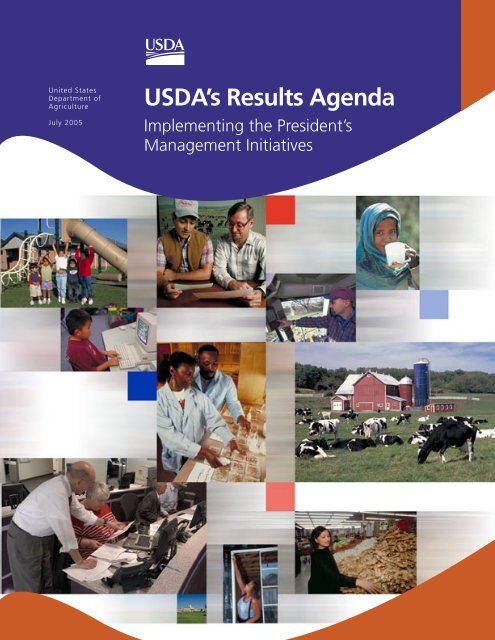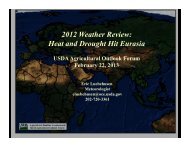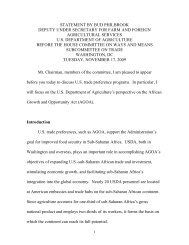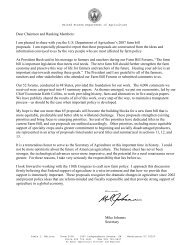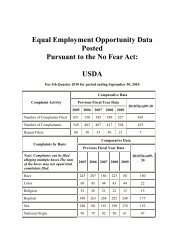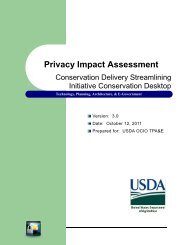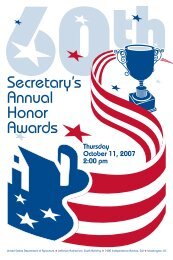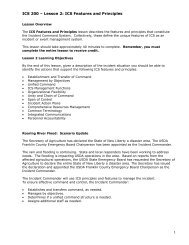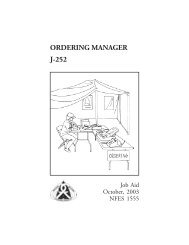USDA's Results Agenda 06.indd - US Department of Agriculture
USDA's Results Agenda 06.indd - US Department of Agriculture
USDA's Results Agenda 06.indd - US Department of Agriculture
- No tags were found...
You also want an ePaper? Increase the reach of your titles
YUMPU automatically turns print PDFs into web optimized ePapers that Google loves.
HUMAN CAPITALIn May <strong>of</strong> this year, 11,114 employeescompleted 1,166 courses. AgLearncurrently <strong>of</strong>fers 1,763 courses.<strong>Department</strong> Actions<strong>US</strong>DA is made up <strong>of</strong> a diverse, knowledgeable workforce<strong>of</strong> people with a broad spectrum <strong>of</strong> technicaland program skills. People are <strong>US</strong>DA’s greatest asset,its human capital. The Human Capital initiative is acritical and central component <strong>of</strong> the goal for employeesto grow pr<strong>of</strong>essionally every year.The challenges <strong>of</strong> human capital are broad. <strong>US</strong>DAmust continue to develop an organizational culturethat promotes high performance standards, ensuresaccountability, and aligns employee performance withdepartment and agency goals.On the 2004 Federal Human Capital Survey, 81percent <strong>of</strong> <strong>US</strong>DA employees responded favorably tothe fact that they are held accountable for achievingresults. This was slightly higher than the governmentwideresponse. Also, 90 percent <strong>of</strong> <strong>US</strong>DA employeessaid that their work is important and that they feelgood about the use <strong>of</strong> technology and employee cooperation.2 <strong>US</strong>DA’S RESULTS AGENDA
All AMS employees can use [its StrategicLearning Plan] as a “hire through retire”way to develop themselves from the daythey join the agency and throughout theirentire careers.articulates performance indicators at the various levels,and suggests formal training and other strategies thatemployees can use to address the competencies. AllAMS employees can use this plan as a “hire throughretire” way to develop themselves from the day theyjoin the agency and throughout their entire careers. Inaddition, this plan will serve as a resource to supervisorsas they work with employees on their IndividualDevelopment Plans, now required for all employees.Prior to FY 2005, an estimated 15 percent <strong>of</strong> AMSemployees used some planning tool to identify andplan for career development and non-technical training.With the introduction <strong>of</strong> the Strategic LearningPlan, 100 percent <strong>of</strong> AMS employees will have a toolto plan their AMS careers, and AMS will be in abetter position to leverage resources.While AMS has a number <strong>of</strong> activities to trainits nonsupervisory and supervisory workforce, theStrategic Learning Plan helped the agency identify aneed to enhance the skills <strong>of</strong> its executive workforce.Seventy percent <strong>of</strong> Senior Executive Service employeesare now eligible to retire, and almost 60 percent<strong>of</strong> GS-15 employees will be eligible within the next 2years. During FY 2005, the AMS Training Instituteintroduced a program that addresses executive corequalifications and created new opportunities for allAMS employees at the GS-14 through SES level todevelop their performance. This effort was introducedin late FY 2004, and has grown during FY 2005.The new executive development program, which islinked to the Human Capital initiative, has increasedparticipation in executive development activities fromapproximately 13 percent in FY 2003 to 40 percent inFY 2005.Food, Nutrition, and Consumer ServicesTo ensure they had the right people in the right jobs,the Food and Nutrition Service and the Center forNutrition Policy and Promotion established teamsto study over 200 administrative and informationtechnology (IT) positions. The goal was to redeploy aminimum <strong>of</strong> 46 full-time equivalents (FTEs) to otherassignments. Employees from all parts <strong>of</strong> the organization,including the affected functions, were involvedin the restructuring effort. FNCS completed restructuring,with a total staff savings <strong>of</strong> 47 FTEs by the end<strong>of</strong> 2004, exceeding the initial goal and freeing up staffto meet other critical agency needs.Food Safety and Inspection ServiceTo increase the scientific and technical skills <strong>of</strong> thefrontline workforce, FSIS is implementing a regionaleffort to ensure that all employees have access tonew training opportunities. It is essential to train theworkforce on policies to address emerging food safetyissues. After just 1 year <strong>of</strong> implementing regionaltraining, FSIS trained over 2,000 employees in themission-critical occupations <strong>of</strong> Consumer SafetyInspector, Food Inspector, and Public Health Veterinarian.This year the agency is expanding the programby <strong>of</strong>fering training to a larger number <strong>of</strong> employeesand expanding the type <strong>of</strong> classes <strong>of</strong>fered.4 <strong>US</strong>DA’S RESULTS AGENDA
Risk Management Agency (RMA). RMA is establishinglong-term and short-term measures and goals,and proposing improvements in the Crop InsuranceProgram that will make it more <strong>of</strong> a complete riskmanagement tool. This includes a long-term measure<strong>of</strong> the value <strong>of</strong> risk protection provided to agriculturalproducers through FCIC-sponsored insurance. InCrop Year 2004, the value <strong>of</strong> risk production providedto agricultural producers increased about $6 billionfrom Calendar Year 2003 levels, and exceeded the CalendarYear 2004 target by about $4 billion. The agencyhas developed a new strategic plan, and its 2006budget includes proposals to improve the program.These proposals include making the program moreequitable in its treatment <strong>of</strong> large and small farms,reducing delivery costs, and ensuring that producersobtain an adequate level <strong>of</strong> protection.Natural Resources Conservation Service (NRCS)As a result <strong>of</strong> the evaluations <strong>of</strong> NRCS programs,the agency determined that it needed to strengthenits performance measures for its programs, includingConservation Technical Assistance, WildlifeHabitat Incentives, National Resources Inventory,Plant Materials, and Farmland Protection and reviseits strategic plan. The long-term measures will beincluded in the final revised strategic plan which isexpected later this year. In addition, the PART evaluation<strong>of</strong> the Resource Conservation & Development(RC&D) Program helped to form the basis for anadministration proposal that was included in the FY2006 budget to eliminate federal financial support forRC&D areas more than 20 years old and to prioritizeand focus the remaining resources on the newerRC&D’s. This resulted in a savings <strong>of</strong> approximately$25 million in the FY 2006 budget.Foreign Agricultural ServiceThe McGovern-Dole International Food for Educationand Child Nutrition Program provides for thedonation <strong>of</strong> U.S. agricultural commodities and associatedfinancial and technical assistance for preschooland school feeding programs in developing countries.The program is in its second year <strong>of</strong> operation.In FY 2003, $100 million was allocated to theprogram and on average 2.25 million meals per daywere distributed. In FY 2004, the program’s secondyear, $50 million was allocated, and on average 2 millionmeals per day were distributed to school childrenand mothers. The <strong>US</strong>DA focused on maximizing thenumber <strong>of</strong> beneficiaries under the program in FY2004. In achieving this goal, <strong>US</strong>DA and its partnerskept the overall level <strong>of</strong> beneficiaries close to the FY2003 level by selecting more direct and efficient feedingprograms.Increased performance was made possible by anumber <strong>of</strong> different actions. As an example, 28 <strong>of</strong> the57 private, voluntary food-distribution organizationapplications were made using paperless Internet applications.This resulted in significant savings in <strong>US</strong>DAand organization staff hours as well as improvedprocessing time.Forest ServiceThe Forest Service is taking numerous steps to streamlineand link business processes—planning, budgeting,monitoring, reporting, and evaluating—into anoverall program <strong>of</strong> Managing for <strong>Results</strong>.The Alaska Region, with its “Credibility ThroughAccountability” initiative, has taken the lead inexploring ways to do this. A year ago, the Region ledthe agency in developing standardized performancemeasures for some 70 program elements. This year,it created the first field-unit-based strategic businessplan. This plan helps the agency link unit capabilitiesand needs to goals and objectives as identifiedin its strategic plan. The region also conducted thefirst data-quality assurance review <strong>of</strong> performancemeasures in response to a national directive. Lessonslearned from these and other efforts are being transferredamong field units via a series <strong>of</strong> peer exchanges.Specific Agency <strong>Results</strong>6 <strong>US</strong>DA’S RESULTS AGENDA
lion. It collected approximately $1.1 billion <strong>of</strong> delinquentdebt during FY 2004, plus an additional $284million <strong>of</strong> delinquent debt during the first quarter<strong>of</strong> FY 2005. <strong>US</strong>DA continues to be a leader in thefederal government in referring 98 percent <strong>of</strong> eligibledelinquent debt to the <strong>Department</strong> <strong>of</strong> Treasury forcollection.Specific Agency <strong>Results</strong>Foreign Agricultural ServiceThe Foreign Agricultural Service (FAS) managesnearly 100 <strong>of</strong>fices overseas and more than $60 millionin reimbursable programs for international activities.In order to manage the agency’s overseas <strong>of</strong>fices andadminister its reimbursable programs, FAS neededspecialized functions to manage its financial data. Tomeet these needs, the agency developed the InternationalFunds Control Reporting System (IFCRS).IFCRS is an online system that includes fundscontrol, budgeting, and reporting capabilities foragency users overseas and in Washington, as well asfor external users.Data are generated at the embassy level by the<strong>Department</strong> <strong>of</strong> State. By giving managers access tomore timely data, IFCRS has allowed FAS to monitoroverseas operations more closely. This has been criticalduring recent months, as the value <strong>of</strong> the dollar,and therefore the cost <strong>of</strong> overseas operations, has fluctuatedsharply. Managers in Washington operationsnow have access to near real-time data. This accessallows them to monitor programs more closely.Office <strong>of</strong> the Chief Financial OfficerThe Office <strong>of</strong> the Chief Financial Officer’s ControllerOperations Division decreased costs by about $1.5million in the last 2 years, while increasing productivity.The time needed to identify cash reconciliationdifferences with Treasury on over 700 Treasuryaccounts, with 60 million annual transactions, hasbeen reduced from 7 months to 2 months throughthe use <strong>of</strong> new automated tools. The number <strong>of</strong> itemsneeding to be reconciled was reduced from 76,000 inSeptember 2003 to 10,000 in September 2004.PROGRESS REPORT ON THE PRESIDENT’S MANAGEMENT INITIATIVES 9
ELIMINATING IMPROPER PAYMENTS:Program InitiativeThe Risk Management Agency (RMA) ismaking significant progress in preemptingfraud, waste, and abuse through theuse <strong>of</strong> data mining, remote sensing, andother advanced technologies. The agencyhas recognized cost savings in excess <strong>of</strong>$320 million since employing data-miningsystems beginning with the 2001 cropyear.<strong>Department</strong> ActionsAvoiding improper payments is one way <strong>US</strong>DA agenciescan make sure that program dollars are spent asintended. <strong>US</strong>DA has made great progress in implementingthe Improper Payments program initiative.In FY 2005, <strong>US</strong>DA identified where improperpayments are being made and the causes. This informationwill be used to reduce and eliminate futureimproper payments at <strong>US</strong>DA. Accomplishmentsinclude:• <strong>US</strong>DA assessed the risk <strong>of</strong> improper payments forits 250-plus programs.• The department completed statistical samples <strong>of</strong>seven programs and used alternative testing onanother. This testing quantified the number <strong>of</strong>improper payments made in each <strong>of</strong> these programsand identified their sources.• <strong>US</strong>DA developed corrective action plans to reduceor eliminate improper payments for every high-riskprogram. Improvement targets were established for8 <strong>of</strong> the 11 high-risk programs.• The department implemented a recovery auditingpilot project to identify and recover improper paymentsrelated to contract disbursements.Specific Agency <strong>Results</strong>Risk Management AgencyThe Risk Management Agency (RMA) is makingsignificant progress in preempting fraud, waste, andabuse through the use <strong>of</strong> data mining, remote sensing,and other advanced technologies. The agency hasrecognized cost savings in excess <strong>of</strong> $320 million sinceemploying data-mining systems beginning with the2001 crop year.Data mining is the process <strong>of</strong> extracting usefulinformation from large amounts <strong>of</strong> data. With datamining and the use <strong>of</strong> spot checks, RMA identifiedfarmers whose losses are inconsistent with those <strong>of</strong>their neighbors. These farmers are subject to a fieldinspection to verify crop losses.Since implementing this program, crop insurancelosses have dropped considerably over the last 4 years.This drop is evidence <strong>of</strong> the integrity <strong>of</strong> the FederalCrop Insurance program, which is important to RMAemployees. Specific cost savings for crop years 2001,10 <strong>US</strong>DA’S RESULTS AGENDA
2002, and 2003 total $241 million. Crop year 2004cost savings reported to date have totaled $79 million.The return on investment using data mining has beensignificant. Since 2001, $17 million has been spent ondata mining efforts. That indicates a cost to benefitratio <strong>of</strong> approximately 1:20. In other words, for everydollar spent on data mining efforts, the Federal CropInsurance Program saves $20 dollars.Food and Nutrition ServiceFood and Nutrition Service employees are continuingto build upon and refine activities for reducing paymenterrors to sustain the program’s peak performancefor the future.The FY 2004 Food Stamp combined national errorrate <strong>of</strong> 5.88 percent is the best rate achieved sincethe inception <strong>of</strong> the program. Program accuracy hasimproved by 34 percent between FY 2000 and FY2004, resulting in a decrease <strong>of</strong> erroneous payments <strong>of</strong>approximately $700 million.To encourage better program practices, the programprovides $24 million in bonuses annually to the10 states with the lowest and most improved error rate.FNS is partnering with States to achieve this resultby developing effective strategies to reduce paymenterrors. Together they are reviewing and monitoringState corrective-action plans and developing strategiesfor error reduction and corrective action.FNS employees also have created a State ExchangeProgram. This program provides funds to statesto obtain, observe, and share information on bestpractices and effective techniques for error reduction.They use a Partnerweb site that allows them to shareinformation and best practices with state administeringagencies to improve results.PROGRESS REPORT ON THE PRESIDENT’S MANAGEMENT INITIATIVES 11
REAL PROPERTY MANAGEMENT:Program initiative<strong>Department</strong> ActionIn addition to accounting for its financial assets, thedepartment is working to ensure that it can accountfor its real property. <strong>US</strong>DA continues its concertedeffort to improve its processes for managing real propertyholdings. Because the goal is to make sure thatfederal property is put to its best use, the Real PropertyInitiative is designed to focus management attentionand increase accountability at all organizationallevels. <strong>US</strong>DA owns approximately 190 million acres<strong>of</strong> land and nearly 22,000 buildings. Additionally,<strong>US</strong>DA agencies occupy 3,700 commercially leasedlocations and more than 1,300 space assignments providedby the General Services Administration (GSA).Through a collaborative effort, the department and itsagencies are working to increase accountability andmanagement <strong>of</strong> these assets through the departmentalAsset Management Plan (AMP).Expected results include better identification <strong>of</strong>unneeded properties for disposal and a more comprehensiveinventory leading to more effective realproperty management. Through these efforts, <strong>US</strong>DAmanagers will be better equipped to address spaceconsiderations for meeting program requirements.An important efficiency initiative contained in theFY 2006 Budget will enable the Forest Service to moreeffectively manage its facilities. The agency has over<strong>US</strong>DA owns approximately 190 millionacres <strong>of</strong> land and nearly 22,000 buildings.Additionally, <strong>US</strong>DA agencies occupy 3,700commercially leased locations and morethan 1,300 space assignments providedby the General Services Administration.40,000 facilities in its inventory—significantly morethan it needs and averaging substantially more thanone building per employee. Legislation proposed aspart <strong>of</strong> the budget will authorize the sale <strong>of</strong> unneededfacilities for fair market value, and the use <strong>of</strong> saleproceeds to address the maintenance backlog. In addition,the legislation will provide for the establishment<strong>of</strong> a working capital fund for facility maintenance thatwill assess programs that use facilities for the maintenance<strong>of</strong> those facilities. Local line <strong>of</strong>ficers will need toassess the number <strong>of</strong> facilities that are needed and thenecessary operating funds to perform facilities maintenance;this creates the incentive to keep the number<strong>of</strong> facilities to a minimum. The rest will be conveyedat fair market value. It is anticipated this action willreduce the agency’s deferred maintenance backlog by25 percent by FY 2010.12 <strong>US</strong>DA’S RESULTS AGENDA
COMPETITIVE SOURCING<strong>Department</strong> Actions<strong>US</strong>DA’s competitive sourcing process enables thedepartment and its agencies to be more effective andefficient with the taxpayers’ money. For example,human resources and competitive sourcing organizationsin <strong>US</strong>DA agencies have taken joint stepsto identify skill imbalances, competency gaps, andorganizational redundancies. The work in this area isexpected to help agency managers to make decisionsabout workforce restructuring and using competitivesourcing.During FY 2004, <strong>US</strong>DA continued to ensure thatthe studies it conducts reflect strategically groupedand related functions to fully realize the benefits<strong>of</strong> this initiative. For example, the department hasissued internal guidance to ensure that feasibilityanalysis, including cost-benefit analysis, is performedbefore activities are scheduled for competition. Thegoal <strong>of</strong> the feasibility analysis is to ensure that functionsselected for public-private sector competitionswill result in lower costs and increased managementefficiencies.In FY 2004, <strong>US</strong>DA completed 16 competitivesourcing studies on 1,487 full-time equivalent positions.It also announced two competitive sourcingstudies on 270 full-time equivalent positions. Theestimated gross savings is $179.2 million over 5 years.Equally important, agencies are provided the flexibilityto re-allocate cost savings to other agency prioritiesor to deficit reduction.landings for affected employees. This plan includedtraining and assistance in resume preparation,employee counseling, Early Out (Voluntary EarlyRetirement Authority), Buy Out (Voluntary SeparationIncentive Payment) authority, and placementassistance. These activities lessened the impact fordownsized employees. They also increased efficienciesand savings for the taxpayers.Forest ServiceDuring FY 2004, the Forest Service conducted aservice-wide competition involving 1,200 FTEs inits information technology services group. Whenthe study <strong>of</strong> the IT function was first initiated, theForest Service’s IT operations were scattered throughoutapproximately 150 locations across the country.A careful evaluation <strong>of</strong> the agency’s needs by its keystakeholders–IT, personnel, budget, legal. and programpersonnel–helped the agency realize that it couldachieve significant savings without a diminution <strong>of</strong>service through consolidation and a more streamlinedworkforce. After performing a best value analysis <strong>of</strong>public and private sector proposals that took both costand technical considerations into account, the ForestService identified the government’s most efficientorganization (MEO) as the best alternative. By relyingon ten computer servers and other restructuredprocesses to effectively meet its IT needs, the ForestService expects to save more than $147 million overthe next 5 years.Specific Agency <strong>Results</strong>Agricultural Research ServiceARS conducted two studies for its Facilities Operationsand Maintenance and Research Farming supportactivities. These studies resulted in wins by theagency as the service provider with its Most EfficientOrganization (MEO) bids. ARS estimates its savingsat $27,285,000 and $3,599,000, respectively, for thesestudies over a 5-year period. The winning MEOsreflected the agency’s responsiveness to the researchenvironment in terms <strong>of</strong> both cost and performance.The agency created a transition plan to provide s<strong>of</strong>tPROGRESS REPORT ON THE PRESIDENT’S MANAGEMENT INITIATIVES 13
EXPANDINGEGOVERNMENT<strong>Department</strong>al ActionsIn the FY 2006 budget, the federal government wouldspend $65 billion on Information Technology (IT)–<strong>of</strong>this <strong>US</strong>DA comprises $1.9 billion. The eGovernmentinitiative ensures that these funds are used to expandthe capacities <strong>of</strong> the department and its employees.With regard to IT, <strong>US</strong>DA is focused on fourthemes: to expand the capabilities <strong>of</strong> employees; toensure that financial investments in IT improve results<strong>of</strong> programs within the department; to identify areaswhere consolidations or common solutions can beachieved across the department; and to ensure thatIT projects are delivered on time with their expectedresults.During the FY 2005 budget process, the departmentdid an extensive review <strong>of</strong> its IT investments.As a result, <strong>US</strong>DA reduced the number <strong>of</strong> IT projectsfrom approximately 500 to 350. The consolidationeffort focused on reducing redundant investmentsand has resulted in $167 million in cost savings thatagencies can now reallocate to serving their customersdirectly.At long last, employees can move fromone department to another and take theirsecurity clearance with them.Additionally, <strong>US</strong>DA began to apply a processcalled Earned Value Management (EVM) to its majorIT investments. EVM shows whether a project is progressingwithin the established budget and schedule.<strong>Results</strong> reported June 1, 2005, showed major investmentswere within 1 percent <strong>of</strong> budget and 4 percent<strong>of</strong> schedule.eClearanceAt long last, employees can move from one departmentto another and take their security clearance withthem. This marks a watershed <strong>of</strong> value for reducingcosts and lost pr<strong>of</strong>essional time while waiting monthsand sometimes years for redundant backgroundchecks and security clearances. <strong>US</strong>DA’s partnershipwith the eClearance Presidential Initiative replaces amanual, paper-based security clearance process withan electronic-based system. <strong>US</strong>DA replaced its disparateagency-level and department security clearanceprocessing systems with new governmentwide securityclearance management tools.14 <strong>US</strong>DA’S RESULTS AGENDA
A customer can obtain an eGovernmentaccount and password, view all <strong>of</strong> his orher NRCS contracts 24 hours a day, 7 daysa week, regardless <strong>of</strong> contract location,and apply for practice payment on-line.eRulemakingThanks to Regulations.gov, commenting online aboutfederal rules and regulations is easier for the public.The eRulemaking Presidential Initiative transformsthe current rulemaking process into an efficient andaccessible process for the public and employees byallowing them to submit online comments for rulesand regulations, along with other supporting documents,and it streamlines internal agency processes.Regulations.gov, a single governmentwide onlineservice, allows the public to access and search allpublicly available regulatory material and commenton proposed rules. The site now includes proposedrules from <strong>US</strong>DA agencies, allowing citizens to locateinformation much more easily from across <strong>US</strong>DA andother federal agencies.Specific Agency <strong>Results</strong>Farm Service AgencyThe Farm Service Agency (FSA) completely automatedthe Conservation Reserve Program signupprocess in a Web environment, saving thousands <strong>of</strong>hours in staff time. Working closely with the NaturalResources Conservation Service (NRCS), FSA wasable to integrate data, minimizing manual intervention.This enabled the department to shorten thesignup period and speed up the decision-makingprocess for accepting bids, which resulted in betterservice to customers. For CRP signup, the decisionmakingprocess was reduced from nearly 2 monthsdown to nearly 6 weeks, saving staff time and millions<strong>of</strong> taxpayer dollars.Natural Resources Conservation ServiceTypically, NRCS employees meet with farmers andranchers at their kitchen tables or in the <strong>of</strong>fice toreview natural resource concerns or to discuss conservationprogram options. This one-on-one approach<strong>of</strong>ten takes between 8 and 60 hours to complete,depending on the size <strong>of</strong> the operation and thecomplexity <strong>of</strong> the situation. As the public’s interest inPROGRESS REPORT ON THE PRESIDENT’S MANAGEMENT INITIATIVES 15
conservation activities continues to rise, NRCS wasconfronted with the need to streamline and improveits ability to deliver programs.To address this situation, NRCS recently pioneereda new method <strong>of</strong> involving private landowners. In thesummer <strong>of</strong> 2004 the agency developed a self-assessmentfor farmers and ranchers interested in participatingin the new Conservation Security Program. Theself-assessment—which is available online, on compactdisk, or on paper—proved successful in givingfarmers a straightforward guide through the firstimportant steps <strong>of</strong> evaluating their resources and theirmanagement. Farmers and ranchers can determine forthemselves whether they are eligible for the program,and whether management changes are needed tobecome even better conservationists. They are able toaccess this information at their convenience and areno longer tied to typical <strong>of</strong>fice hours.Another way NRCS is increasing results for agricultureproducers is the Program Contracts System(ProTracts). This is a Web-based application thateliminates paperwork and streamlines the programcontracting process for the Environmental QualityIncentives Program, the Wildlife Habitat IncentivesProgram, the Conservation Security Program, and theAgricultural Management Assistance Program. Pro-Tracts has a built-in rules checker and internal paymentcalculator function that eliminate administrativecontracting errors. This reduces the need for clientsto travel to a local <strong>US</strong>DA Service Center in order toapply for programs and payments, obtain governmentforms, or review contract-related forms. A customercan obtain an eGovernment account and password,view all <strong>of</strong> his or her NRCS contracts 24 hours a day,7 days a week, regardless <strong>of</strong> contract location, andapply for practice payment on-line.A followup study <strong>of</strong> the effectiveness <strong>of</strong> ProTractsshowed that developing a contract using ProTractssaved about 30 percent <strong>of</strong> the time it took to completecontracts manually. This is good for NRCS employeesand agricultural producers.Agricultural Marketing ServiceIn May 2005, the Agricultural Marketing ServiceMarket News Program—“the eyes and ears <strong>of</strong> Americanagriculture”—created and implemented a newWeb portal to greatly enhance the delivery <strong>of</strong> criticalmarket information to the public via the Internet.Fruit and vegetable market news information is thefirst data accessible via the market news portal. Livestockand grain information is being developed, andother commodities will follow.The portal allows the public to customize an AMSMarket News Website to meet their needs, providesusers with direct access to the AMS Market Newsdatabase <strong>of</strong> historical information, and allows usersto choose their format for receiving data. Users candirectly query the database <strong>of</strong> market information,tailoring their reports by commodity, date, variety,shipping point, or destination market.Celebrating its 90th anniversary this year, the AMSMarket News Program has moved from issuing itsreports by telegraph in 1915, to access via the Internettoday. Some 270,000 report titles are issued each year,reaching more than 300 million users in the UnitedStates and around the world. In 2004, the AMSMarket News Website received over 22 million hits.With the addition <strong>of</strong> a true Web portal, the large array<strong>of</strong> AMS Market News users can now access informationfaster, easier, and in formats that more readily fittheir needs.Celebrating its 90th anniversary thisyear, the AMS Market News Programhas moved from issuing its reports bytelegraph in 1915, to access via theInternet today. Some 270,000 report titlesare issued each year, reaching more than300 million users in the United Statesand around the world. In 2004, the AMSMarket News Website received over 22million hits. With the addition <strong>of</strong> a trueWeb portal, the large array <strong>of</strong> AMS MarketNews users can now access informationfaster, easier, and in formats that morereadily fit their needs.16 <strong>US</strong>DA’S RESULTS AGENDA
FAITH-BASED ANDCOMMUNITY INITIATIVE:PROGRAM INITIATIVE<strong>Department</strong> ActionsFor years, <strong>US</strong>DA has partnered with faith-based andcommunity organizations to help deliver food andother vital assistance to those in need. <strong>US</strong>DA’s Faith-Based and Community Initiatives (FBCI), a PMAprogram initiative, is working to strengthen theseexisting partnerships and create new ones to reacheven more people in need. Faith-based and communitygroups represent a valuable asset in <strong>US</strong>DA’sefforts to reach more people with its programs andbe more successful in alleviating hunger and buildingstronger communities.FBCI is strengthening <strong>US</strong>DA’s partnerships withfaith-based and community groups in a number <strong>of</strong>ways, including:Creating a level playing fieldA key principle <strong>of</strong> FBCI is that all groups—religiousor secular, large or small—should compete on a levelplaying field when applying for federal assistance.Therefore, FBCI works to ensure that faith-based andcommunity groups, especially those that have notpartnered with the government before, have equalaccess to <strong>US</strong>DA programs. In July 2004, <strong>US</strong>DApublished its final general rule, “Equal Opportunityfor Religious Organizations,” which outlines opportunitiesfor faith-based organizations to apply forand compete on an equal footing with other eligibleorganizations that receive assistance from <strong>US</strong>DA.FBCI is empowering faith-based andcommunity groups with information andtechnical assistance to deliver <strong>US</strong>DAprograms to the individuals who needthem most.programs through FBCI. Now, Starfinder is providinghundreds <strong>of</strong> hungry youngsters with healthful mealsthrough the Summer Food Service Program.Empowering groups to advance <strong>US</strong>DA goalsFBCI is empowering faith-based and communitygroups with information and technical assistance todeliver <strong>US</strong>DA programs to the individuals who needthem most. Many individuals who qualify for andneed <strong>US</strong>DA assistance do not know what servicesare available, how to access them, or where to receivethem. Local faith-based and community groups areacting as a bridge between <strong>US</strong>DA and those in needthrough education and service delivery. These groupsare helping low-income individuals apply for housingloans and rehabilitation grants, obtain food stamps,and receive many other benefits.Engaging new groups in <strong>US</strong>DA programsFBCI conducts outreach activities to engage morefaith-based and community groups in <strong>US</strong>DA programs.Working with newer and smaller groups ishelping <strong>US</strong>DA reach people it has not reached before.One <strong>of</strong> these new partnerships is with the StarfinderFoundation, a community group in Philadelphia thatprovides a positive summer learning program for children.Last year, after hearing a number <strong>of</strong> complaintsabout stomachaches, the staff learned that many <strong>of</strong>the children had had nothing to eat for breakfast.Then Starfinder heard about <strong>US</strong>DA’s summer feedingPROGRESS REPORT ON THE PRESIDENT’S MANAGEMENT INITIATIVES 17
Specific Agency <strong>Results</strong>Farm Service AgencyIn FY 2003, <strong>US</strong>DA’s Commodity Credit Corporation(CCC) owned 1.2 billion pounds <strong>of</strong> nonfat dry milk.The <strong>US</strong>DA feeding programs were not using the milkrapidly enough to remove the CCC-owned inventory.In response, the Farm Service Agency (FSA) developedthe National Nonpr<strong>of</strong>it Humanitarian Initiative tohelp feed hungry individuals in the United States whoare experiencing unfortunate and difficult situations.By March 2005, approximately 75 nonpr<strong>of</strong>it organizations,many <strong>of</strong> which had never before received<strong>US</strong>DA commodities through FSA, were participatingin this opportunity. These organizations were now ableto service hundreds <strong>of</strong> local foodbanks, shelters, andother hunger relief organizations in almost every State.For example, the First Baptist Church <strong>of</strong> Leesburg,FL, participated in the National Nonpr<strong>of</strong>it HumanitarianInitiative. The church received and then redistributedthe milk to the social service center, whichassists more than 4,000 people each year with food,clothing, and financial assistance. In addition, FirstBaptist distributed the milk to the Men’s Shelter, theWomen’s Care Center, the Benevolence Center, theCommunity Medical Care Center, and the Saturday-Sunday School program for inner-city children.In Chicago, Catholic Charities Emergency Assistancedistributed much-needed milk to a number <strong>of</strong>sites throughout the metropolitan area—from the St.Vincent Center in Chicago to the Cardinal BernardinCenter in Waukegan. The milk helped nourish a greatnumber <strong>of</strong> poor families with children, poor elderly,and disabled individuals. Typically, 100,000 individualsare served through Chicago’s Catholic CharitiesEmergency Services annually.18 <strong>US</strong>DA’S RESULTS AGENDA
Rural DevelopmentRural Development is working to identify and removeother barriers that prevent a level playing field forfaith-based organizations. One <strong>of</strong> the best illustrations<strong>of</strong> this point is Rural Development’s interaction withthe Willcox United Methodist Preschool in Willcox,AZ. Last year, the preschool received $350,000 inloan and grant money from <strong>US</strong>DA’s Rural Developmentto build a new daycare facility. The new facilitynow <strong>of</strong>fers high-quality daycare to 70 children up to5 years old living in a traditionally underserved area.Assistance to this group would not have been possibleprior to 2004 because <strong>of</strong> an eligibility barrier.Changes made to level the playing field allowed thisand another community group to participate in thisgrant program.The Mennonite Housing Rehabilitation Services inWichita, KS, assists people who cannot afford homerepair, decent housing or home ownership in anyother way. Last year, this faith-based group receivedalmost $300,000 in grant funds that allowed for theconstruction <strong>of</strong> 18 homes for low-income and verylow-incomefamilies. In addition, the group providedguidance to families on construction, maintenance,and credit issues to encourage successful first-timehomeownership, and enable these families to attainbetter creditworthiness.PROGRESS REPORT ON THE PRESIDENT’S MANAGEMENT INITIATIVES 19
LOOKING FORWARD<strong>US</strong>DA continues to build on the department’s longhistory <strong>of</strong> accomplishments. The goal is to increasethe tools available to employees to do their jobs moreeffectively as they serve the public and accomplishtheir program aims.In September 2005, <strong>US</strong>DA will issue an updateddepartmental Strategic Plan, which will provide thegoals and objectives the department will work toachieve for the next 5 years. Also, the department willbe focusing even greater attention on accountability,to ensure that it produces the intended results.In the next year, the Human Capital initiative willcontinue to focus on succession planning, recruitment,and retention, reduction <strong>of</strong> skill gaps, continuation<strong>of</strong> strategically linked performance appraisals,and pr<strong>of</strong>essional development programs.As the department and its agencies develop the FY2007 budget, the Budget and Performance Integrationinitiative will concentrate on actions to address PARTfindings and to improve program efficiencies. Efficiencymeasures will be developed and improved andperformance measures will be reviewed with seniorlevel managers.For the Financial Management initiative, thedepartment will continue to provide timely andaccurate information to managers, strive to maintaina clean audit, and partner with the <strong>Department</strong> <strong>of</strong>Treasury to reduce delinquent debt. Also, <strong>US</strong>DA willimplement a corrective action plan, developed in FY2005, to reduce and recover improper payments.In FY 2005, <strong>US</strong>DA will conduct feasibility studiesfor potential public-private competitions coveringover 1,000 FTEs. Based on those, and private sectormarket research, full Competitive Sourcing studiescould be conductedImplementation <strong>of</strong> the Expanding eGovernmentinitiative will further improve on employee capabilitiesand provide greater tools to achieve <strong>US</strong>DA’s goals.In the next year, the initiative will continue to focusIT investments on common solutions and consolidationacross the department and governmentwide.Also, it will continue to ensure that IT projects aredelivered on time and with their expected results.As the Faith-Based and Community Initiative(FBCI) looks to the next year <strong>of</strong> its work, it will continueto engage and empower new groups as partnerswhile identifying additional ways that these groupscan help <strong>US</strong>DA advance its FBCI goals <strong>of</strong>: ensuringsuccess by measuring results, identifying new waysto support <strong>US</strong>DA goals, and expanding on currentefforts to ensure a level playing field.20 <strong>US</strong>DA’S RESULTS AGENDA
The U.S. <strong>Department</strong> <strong>of</strong> <strong>Agriculture</strong> (<strong>US</strong>DA) prohibits discriminationin all its programs and activities on the basis <strong>of</strong> race, color, nationalorigin, sex, religion, age, disability, political beliefs, sexual orientation,and marital or family status. (Not all prohibited bases applyto all programs.) Persons with disabilities who require alternativemeans for communication <strong>of</strong> program information (Braille, largeprint, audiotape, etc.) should contact <strong>US</strong>DA’s TARGET Center at(202) 720-2600 (voice and TDD).To file a complaint <strong>of</strong> discrimination write <strong>US</strong>DA, Director, Office<strong>of</strong> Civil Rights, Room 326-W, Whitten Building, 14th and IndependenceAvenue, SW, Washington, DC 20250-9410 or call (202)720-5964 (voice or TDD). <strong>US</strong>DA is an equal opportunity providerand employer.Mention <strong>of</strong> a trade name or brand name does not constituteendorsement or recommendation by the <strong>Department</strong> over similarproducts not named.PROGRESS REPORT ON THE PRESIDENT’S MANAGEMENT INITIATIVES 21


